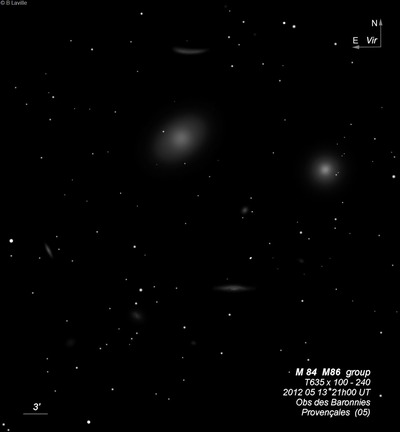
Charles Messier is credited with the discovery of M86 = NGC 4406 = h1253 on 18 Mar 1781, along with M84, and described a "Nebula without star, in Virgo, on the parallel and very near to the nebula above, No. 84: their appearances are the same, & both appear together in the same field of the telescope." But Wolfgang Steinicke recently found (email Oct '16) that Johann Gottfried Koehler made the original discovery on 5 May 1779. WH only recorded it on 17 Apr 1784 (sweep 199) and simply noted "B. Is No. 74 of the Connoissance des Temps." JH listed M86 as a "Nova", probably due to the poor positions of his father. On sweep 22 he logged "vB; R; gbM to nearly a star" and on sweep 243 "vB; L; pgmbM; r."
300/350mm - 13.1" (5/14/83): very bright, larger and more elongated than M84.
400/500mm - 17.5" (4/25/87): very bright, fairly large, slightly elongated 4:3 NW-SE, 4'x3', intense core, substellar nucleus, large diffuse halo. One of the two brightest galaxies in the core of the Virgo cluster along with M84 17' W. NGC 4402 lies 10' N.
600/800mm - 24" (4/28/14): at 260x appeared extremely bright, very large, oval 3:2 NW-SE, 4.5'x3.0'. Sharply concentrated with a very intensely bright core that increases down to the center. The halo increases in size with averted and gradually fades out at the periphery. Brightest galaxy in the central core of the Virgo cluster.
Notes by Steve Gottlieb